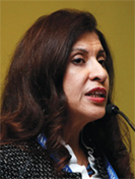Paleoradiologists Unravel the Secrets of Ancient Mummies
Imaging helps uncover the history and mystery of ancient Egypt

All images courtesy of Sahar Saleem, MBBCH, MSc, MD
When the ancient Egyptians mummified their dead, they did so without recording details about the process, which was intended to preserve the body so the soul could reclaim or “recognize” it after death.
And while the ancients sought to keep the process a secret, radiologists — or more specifically, paleoradiologists — are using imaging to unwrap the mysteries of mummification and reveal astonishing details about the people hidden beneath the linen wrappings.
“The Egyptians left no writings about the process for mummies, and yet they wrote about most aspects of their lives,” said Sahar N. Saleem, MBBCH, MSc, MD, a radiologist at Cairo University, Egypt, who spoke about paleoradiology at RSNA 2017. “They wanted to keep it a secret.”
But since the x-ray was discovered in 1895, paleoradiologists have been unlocking those ancient Egyptian secrets, one image at a time.
Captured in 1896, the first radiographs of mummies were helpful, but were often fuzzy and did not reveal the specific details researchers were seeking. When CT was introduced in the 1970s, it provided a level of detail that made CT the method of choice for examining mummies.
“X-rays can only see two planes, but CT scanning can differentiate among the various types of bone and soft tissue,” said Dr. Saleem, who studied scanning mummies in Canada and has been studying royal mummies of the New Kingdom in Egypt since 2005.
Multi-detector CT scanning of ancient human remains has helped researchers understand ancient cultures, revealed the secrets of mummification and provided a deeper level of information on the origin and natural history of diseases. And more recently, 3-D printing technology has allowed radiologists to create 3-D printed models of amulets and jewelry inside the bodies of the mummies.
CT Solves Ancient Murder Mysteries
In recent years, Dr. Saleem and colleagues have used CT to help solve two mysterious deaths that took place in ancient Egypt, including that of the world’s most famous pharaoh, King Tutankhamun.
While a bone chip inside his skull had fueled suspicion that Tut had been murdered, the CT scan of the mummy in 2005 determined that the bone was detached from a broken neck vertebra during the autopsy executed by Howard Carter in 1925. Tut, as it turns out, died of malaria and complications from a broken leg (also detected by CT) and likely walked with a cane. More than 160 canes were found in his tomb.
Dr. Saleem also helped solve the murder of Ramesses III, the Egyptian pharaoh who lived from 1190–1070 BC. When Dr. Saleem, with renowned Egyptologist Zahi Hawass, PhD, and other researchers, first scanned the mummy in 2012, they determined that Ramesses III died when someone slit his throat with a sharp knife.
When reassessing the pharaoh’s CT scans in 2015, Drs. Saleem and Hawass determined that Ramesses III had sustained injuries from different types of weapons, suggesting that more than one assailant was involved. The researchers detail the story of Ramesses III in their 2016 book, “Scanning the Pharaohs.”
“Imaging also revealed that Ramesses’ big toe was chopped off,” Dr. Saleem said. “From what we discovered, it was likely a very bloody scene.”
In researching the mummification process, Dr. Saleem determined that subcutaneous packing was used in mummies including those of Tutankhamun and Ramesses III. In the process, the ancients inserted resins and other fillers under the skin to preserve the looks of the dead — essentially an early form of cosmetic surgery. Egyptians believed preserving the looks of a dead person would help the soul more easily find its body.
“We discovered that the ancient Egyptians must have had substantial knowledge of anatomy as well as considerable surgical skills,” Dr. Saleem said.
Ensuring the Legacy of Egyptian Mummies
Along with the royals, ancient Egyptians also mummified millions of bodies, including those of common people, Dr. Saleem said. After a massive excavation in the 19th Century, mummies were so plentiful in Europe and America that they were often unwrapped publicly and at private parties held by the elite. Dr. Saleem called the events “freak shows.”
“Thousands of mummies were ground up and used as powder and even for fertilizer,” Dr. Saleem said.
The discovery of the x-ray a short time later gave researchers the ability to see beneath the cloth wrappings and piece together the individual stories — adding value and dignity to each person’s life.
Dr. Saleem, who does much of her research at the Museum of Cairo, spends her time in the museum’s basement, which is filled with sealed artifacts that have never been studied. The museum, one of the only in the world with a CT scanner, has some 160,000 pieces on display and regularly exhibits those identified by CT. The museum also has a database of information related to imaging the artifacts, she said.
During the RSNA 2017 session, Gerald J. Conlogue, MHS, RT, presented on his experience in field imaging of mummies in their tombs, while Andrew J. Nelson, PhD, discussed his work on micro CT in archaeology.